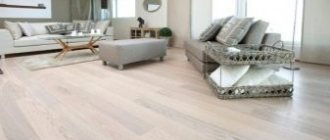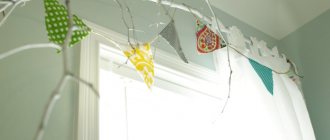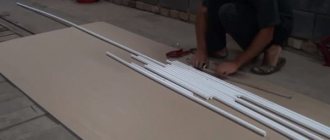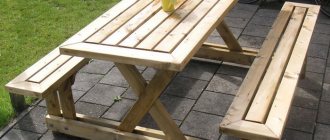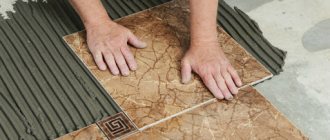Parquet boards are often used for flooring because they are considered an environmentally friendly material. Although over time his condition may worsen. Due to prolonged or improper use, the shine disappears, scratches and other defects form.
To prevent damage to the floor covering, it is worth understanding how to care for and use it. Prevention and minor updating will be beneficial. When serious deformation occurs, there are many ways to restore its former shine and beauty. At the same time, you don’t always need to call a specialist - you can handle the task yourself. How to update parquet? The answer to this question is below.
Restore original shine and beauty
Renewing parquet without sanding is not as difficult as it might seem at first glance. Before starting work, it is worth understanding what the reasons for such deviations lie. Most often, it is improper care that leads to scratches appearing and the coating losing its former appearance. To avoid repeated defects after restoration, you need to follow simple operating rules:
- It is worth treating the entire area with wax or special means once every four weeks. More attention is paid to places with active movement of people.
- There are special spray varnishes. They are suitable for those areas where burrs have already appeared.
- There are products to restore shine - they can be used once every 14 days.
- When the parquet board is not too thick, maintenance should not be wet. Or you can use oil or wax as a base - this composition helps it last longer. Treatment - once every two weeks.
If you follow these rules and perform basic care procedures, the service life will double. Those people who choose this particular finishing coating must understand how it is done.
Materials for coating parquet with varnish
Not every property owner knows how to cover the parquet after sanding. Before varnishing, you can apply the following solutions to the floor covering:
- Antiseptics protect wood flooring from damage by fungus and mold, and protect against the effects of microorganisms and insects.
- Fire retardants increase the fire-fighting properties of parquet and protect the surface from fire as a result of the influence of open fire.
- Water-repellent impregnation penetrates deeply into the pores of the wood, preventing exposure to moisture, which leads to deformation of the dies.
Important! Special attention must be paid to the primer. This composition fills all microscopic cracks and improves the adhesion of the base surface. The primer is not applied before impregnating the parquet with oil.
Special compounds will help change the base color of the floor covering. How to tint parquet before applying varnish. To do this, you can use colored oil or a special solution, stain. Such substances highlight the wood texture and improve the depth of shades even for light flooring options.
Colored oil with special coloring pigments gives the parquet a beautiful noble tone and highlights the wood texture. This solution consists of natural components; after its application, you can obtain a coating that is resistant to moisture and chemical detergents. Using oil, you can artificially age wood, but to do this you need to walk over the surface with a hard metal brush.
Interesting article on the topic: Parquet scraping: stages, equipment, technology
A good effect can be achieved by using stain. This composition allows you to obtain a smooth, rich floor covering. The stain penetrates deep into the structure of the material, but the pores are not clogged, allowing the wood to breathe.
How to remove minor defects?
Minor changes to the surface of the parquet are the easiest to remove. The simplest method is grinding. The simplest process is a special machine, not everyone has one, so sandpaper will help. Using paper is not so easy, but there are simple recommendations that can speed up this process:
- You need to stick sandpaper of different grits onto any comfortable shoes.
- When it is glued, the shoes are put on your feet, after which you just need to shuffle along the parquet board on the floor.
- When the work is completed over the entire area, waxing is used.
If the floor has a new finish, then preventive maintenance is performed immediately (once a month). For the old one, you will have to do this procedure more often so that it does not deteriorate at all. This procedure is simple and does not take much time.
Working moments
Before you independently restore parquet without sanding, you need to master two common techniques: simulating seams and preparing putty to match the tone of the floor.
How to make putty
If you wish, you can buy a ready-made mixture at a hardware store - there are many different solutions of any tones on sale. But if you still have a couple of old parquet floors (the same as on the floor), then you can prepare a suitable putty yourself. To do this, you need to make sawdust and add it to the parquet varnish, mixing the grout to a thick consistency. But preparing the solution yourself is only possible if exactly the same samples of wood remain.
Imitation seams
It is very simple to create the effect of joints after putty, using a regular metal ruler and an awl. For this:
- wait for the grout to gelatinize until it does not “grab” but still retains its softness. If you use alkyd varnish, you will need to work quickly, since it dries in a few minutes;
- draw straight joints with an awl along a ruler;
- make curved false joints if necessary using the rib tool.
Just a few tricks - and the work with putty will not be noticeable at all.
Removing scratches
Since scraping parquet is expensive and not always practical, you need to figure out how to eliminate defects yourself. You can try to remove ordinary scratches and gouges with a hand scraper and sandpaper. To do this, the old varnish is removed from the damaged area, and prepared cosmetic putty is applied to the scratch. After hardening, it should be sanded and false joints created using the above method. Then you can varnish the floor. When deciding which varnish is best for parquet after sanding or less extensive processing, base it on the required service life of the coating.
You can try to remove small scratches with a wax pencil.
Repairing clefts
If, during the operation of the floor, gaps have formed between the dies, then more complex work will be required:
- Heat the dies laid parallel using a hairdryer for 10–13 minutes. You will know that they have reached the desired temperature by the specific aroma of the mastic;
- Using a hook rule and a hammer, pull the parquet flooring one to the other, leaving 1 small gap;
- Place a wooden insert into the resulting opening and seal the seams with mortar;
- after the putty has dried, sand the area and varnish;
- For herringbone installation, grout wide cracks separately.
If the distance between the cracks is less than 5 millimeters, then you can use the recommendations for repairing scratches and chips.
Can putty be used?
Experts believe that it is not necessary to perform grinding - you can resort to puttying. Most often, this option is suitable in cases where there are serious violations of the integrity of the surface. The principle of the method has some nuances:
- You need to buy putty to match the color of the parquet.
- Then spread the restoration paste over the surface.
- When everything is dry, the coating is treated with fine sandpaper.
- After this, you need to treat the floor with wax (rub it).
In order for the parquet to acquire its previous appearance, it is necessary to create the joints of the boards. There is a simple method for this:
- To work you will need an awl and a ruler.
- Using a ruler, apply pressure at the joints (you should get a seam).
- The false pins are created with an awl, making longitudinal stripes exactly along the ruler.
- Now you need to complete the coating. For this purpose, water-based parquet varnishes are used. They are safe and effective in this type of work.
To ensure that the coating is reliable and of high quality, the area is treated with varnish twice. Once everything is dry, you should use wax for rubbing. As you can see, updating parquet flooring is quite simple. All these procedures are beneficial and add shine to the floor.
Restoration of individual parquet strips
Individual planks are replaced if cracks, creaks, bulges, etc. appear. This process is more labor-intensive, and many resort to the help of experienced craftsmen.
The cracks are formed as a result of the fact that the wood tends to absorb and release moisture. Together with the wrong one, this leads to the appearance of cracks. This problem is eliminated in a standard way: the baseboards are removed, the surface is cleaned of varnish and various contaminants. Then the floor is scraped and vacuumed. Be sure to remove all debris inside the cracks. After which the cracks are puttied, dried and varnished.
To eliminate squeaking, remove the baseboards and check the wedges between the parquet and the walls. Sometimes they dry out, which leads to squeaking.
We eliminate the creaking of parquet in two steps: 1 - Drill a hole in the place where the die creaks, 2 - Using a syringe, fill in two-component parquet adhesive
If creaking is caused by wear-and-tear unevenness in the base of the floor, which appears over time, then a small hole is made in these places and glue or concrete is poured to level the base of the floor. If this does not help, and the squeak remains, then you will have to reinstall the entire parquet.
In the case of swelling of a parquet floor, proceed as follows: a specific area is heated with a hairdryer, something heavy is placed on it, if the swelling has become smaller, the procedure is repeated.
If the planks begin to move away from the base of the floor, then it is best to replace them.
They are removed using a chisel and hammer. Using a narrow spatula you can remove any remaining material, old glue and clean out the resulting depression. The new strip is adjusted to size, cut and glued. The glue is applied to the base of the floor. After gluing, the plank should be under pressure for at least 24 hours. And then the floor area is puttied, sanded and varnished.
Restoring a parquet floor is not such an impossible task. Of course, this process is very responsible and labor-intensive, but it is quite doable, especially if you handle the tools correctly and have certain knowledge. And yet, many experts recommend that before you start working with parquet on your own, you should practice doing repair work with professionals in order to master the technique and already know exactly how to renew parquet without mistakes. Leave your comments on the article in the form below!
No matter what new types of floor coverings appear on the building materials market, parquet still retains its reputation as the most beautiful classic floor covering, giving the interior elegance and respectability. The advantages of parquet also include ease of maintenance and long service life.
However, no matter how long this period may be, in the end you have to think about restoring and updating the parquet due to the wear and darkening of its tiles. The most radical way to update would, of course, be sanding parquet floors, but this pleasure is very expensive and labor-intensive, especially since you will have to resort to the services of a specialist with a sanding machine.
Preliminary preparation of parquet
We offer several ways to renew your parquet flooring using not too complicated cosmetic care. But first of all, you need to take care of cleaning the floor surface from adhering contaminants (chewing gum, plasticine, etc.). They can be easily removed by placing a plastic bag filled with ice cubes on the contaminated area. After 20-25 minutes, the stain will come off very easily.
Scratches and chips inevitably appear on any floor covering that is used for a long time. They are eliminated using a special putty, which is rubbed over the damaged areas, and then varnish is applied to them.
If the parquet does not need serious restoration, but only needs to be sanded in some places, then this can be done manually, or rather, “by foot”, by attaching sandpaper to old shoes.
What varnishes are used for protective coating
Parquet must be varnished, which gives it not just a shiny (in every sense) appearance, but also protects it from moisture. Currently, there are mainly four types of varnishes used:
- alkyd and uralkyd - inexpensive, quick-drying, but not very durable (no more than 10 years);
- acrylic and epoxy - with a minimal level of toxicity (however, when working with them, it is necessary to use a respirator), high durability (up to 50 years); However, if the sun's rays fall on the parquet, its wood may fade slightly and change its color scheme.
How to get rid of a squeak
The parquet begins to creak due to severe wear and high air humidity, which normally should not exceed 40%. It can be checked with a hygrometer. To do this, it is best to remove the parquet along the edges and then take measurements. If the value exceeds 60%, then you cannot do without the help of professionals.
Sometimes the cause of squeaking is wear of the spacer wedges under the baseboards. Having removed the baseboards, you can check their condition and replace them with new pairs, which are installed every 50-60 cm and tapped tightly. You should knock until the creaking stops.
How to get rid of swelling of parquet
This problem can be solved independently only if the swelling area is small and a small amount of water was spilled. There is probably a hairdryer in the house, but it will take about an hour and a half to thoroughly dry the swollen area of the parquet. Immediately after this, while the parquet is still hot, it is covered with a thick cloth, and a load is evenly placed on top at the rate of 10 kg per 1 dm 2.
Please note that it is advisable to carry out drying immediately after water or other liquid has been spilled on the parquet, then unpleasant consequences can be avoided. If you start doing this after 7-10 days, then all efforts will be useless due to the proliferation of spores and fungi in the flooded area.
The main enemies of parquet
Parquet has three main enemies:
- air humidity, not only excessive, but also insufficient;
- ultraviolet radiation (so try to prevent direct sunlight from hitting the parquet - just close the curtains during the day);
- sand carried on the soles of shoes.
However, with regular and proper care, parquet floors will delight you with their appearance for a long time.
« »
Parquet flooring is rightfully considered one of the most luxurious and attractive. The natural material is environmentally friendly, and its excellent performance characteristics ensure the floor's service for many years. However, over time, the surface of the parquet wears out and wears out, and various defects appear. The most radical way to eliminate them is with varnish. But often the problems are not significant enough to require such a process. But how can you renew parquet without sanding and return it to its former beauty?
How to deal with serious problems?
Before installing parquet flooring, it is worth assessing the complexity of the work in order to choose an effective method. With a long and improper period of use, the boards diverge. Many people believe that such a finishing coating has to be dismantled and a new one laid. There is always a solution for this problem:
- You can drive small nails at a 45 degree angle into each board.
- To deepen these fasteners, use a special rod or something similar.
But sometimes it’s not just one die that fails, but the entire perimeter. What to do in this case? Before updating the parquet, it is worth cutting special bamboo inserts. They will come out. To trim them, use any sharp object. Places of such addition can be covered with putty and masked with wax.
How to update old parquet? When this question arises, you have to pay attention to the general condition. The reasons are varied. Sometimes nothing is visually noticeable, but there is a slight creaking or any other sound. There is no need to invite a specialist, because many types of work can be done independently.
Determining the scope of work
Depending on the nature and extent of damage to the old coating, the scale of repair is determined. If the old parquet is very worn out, the boards have a large number of cracks, darkening and chips, it must be completely dismantled.
If defects appear only on some elements of the coating, the strips can be carefully removed and replaced with new ones.
If the boards are fairly well preserved, but have unsightly scratches, chips, and the floors themselves have begun to creak unpleasantly, you can do without dismantling. In this case, it is enough to restore the parquet and make minor repairs.
Situations also often arise when the coating has not yet lost its presentability, but the owners of the room decided to change the decor and change the floor covering. In this case, you can very carefully remove the expensive material and put the old parquet in another room.
We will tell you below how to do the job correctly in each of the above cases.
Sounds when walking
Oddly enough, the appearance of squeaking is the most common reason. The boards are drying out. Before updating the parquet with your own hands, you need to identify the places where such deviations exist. Sometimes, even with proper use of the coating, an unusual sound appears. This situation should not be ignored.
Of course, there are cases when it is impossible to remove the squeak because the base was not leveled initially. In such a situation, it is necessary to completely dismantle and level the rough concrete floor. Although this can be avoided. How to update old parquet without sanding? You will need to make wedges and install them on the floor around the perimeter.
When can you not do without scraping?
If the parquet is severely damaged, it will not be possible to do without a specialist and professional equipment. Examples of such damage:
- pronounced dents from active use or heavy furniture;
- wavy cracks of planks;
- swelling and swelling of wood from water;
- change in structure and color;
- mold and rot.
In these situations, drying, reassembly, replacement of individual planks, and treatment with special compounds are required. It is necessary to do looping in these cases.
Why is it better to entrust the renovation of old parquet to specialists?
You can restore the parquet yourself. But most property owners prefer to involve specialists, which allows them to get the following advantages:
- Saving personal time and effort. There is no need to do everything yourself, the master will do the job quickly. The freed time can be devoted to loved ones.
- Saving money. When you restore a floor yourself without experience, mistakes are possible. To correct them, you need to purchase materials again, and sometimes pay for the work of other people.
- Optimal choice of materials. The master will calculate exactly how much varnish, paint, and putty is needed. You won't have to buy anything extra. Company representatives can buy and bring everything they need themselves. There is no need to buy tools: the master has everything.
- Guarantee. Our craftsmen provide a guarantee on the results of their work and materials.
Any parquet sooner or later undergoes restoration, since it is this flooring that is installed for many years. Parquet has many positive qualities: a beautiful and rich appearance, naturalness, etc. Therefore, everyone wants to preserve such material for as long as possible, eliminating various types of damage. Moreover, a complete replacement of parquet will require significant costs, and restoration of parquet is the best way out. Some prefer to restore parquet with their own hands, while others believe that parquet restoration should be carried out exclusively by specialists.
If we talk about the types of restoration of parquet floors, then we can name two main categories - restoration of the floor surface and replacement of individual sections. The process of replacing dies is much more complicated and therefore requires more time and effort. This means that if you do not have complete confidence in your abilities, it is better to use the services of professionals. If, after all, the restoration of the parquet is done with your own hands, then you should be patient and study all the necessary information to carry out this process.
It is better to rent a sanding machine if the restoration of the parquet will be carried out on your own on a one-time basis
Restoring parquet will require the use of certain materials and tools. Usually, tools for renovating a floor are very expensive and are unlikely to be useful in the future, so the smartest thing to do is to rent them. To understand the full picture of how to restore parquet, you should familiarize yourself with the list of tools:
- Looping machine. You can also use a regular cycle;
- Grinding machine. A set of sanding attachments that have different grain sizes;
- Vacuum cleaner;
- Hammer and chisel;
- Hacksaw and drill;
- Spatulas of various widths;
- Brushes and rollers;
- Special clothing, soft shoes, safety glasses and a respirator.
More details about the restoration process in the video:
The necessary materials include the following:
- Parquet dies. They will be required if the floor is severely damaged, and the only option for restoration is to replace individual parts of the parquet;
- Putty;
- Parquet glue;
- Mastic or varnish;
- Oil or stain.
Subsequence
This procedure is simple, but as a basis you should choose any available instruction and follow it:
- There should not be high humidity in the room, otherwise it will not be possible to create the required conditions. This figure should not exceed 50%.
- The plinths are dismantled and only after that wedging begins.
- If old wedges were installed, they are removed.
- At a distance of about 40 centimeters, new ones are laid out.
- After which, over the course of 7 days, it is worth periodically sealing the inserts, while checking the surface for squeaks.
When this period of time is not enough to correct the situation, the reason lies in more serious deviations. You will have to carry out complete dismantling or come to terms with the presence of such sound. It is believed that the simplest task is to renew the varnish on the parquet. After a little time during operation, it “goes away” in places of active movement. It is not difficult to eliminate such a defect.
Types of parquet repair
There are two types of partial repair of this floor covering:
- surface;
- correction of individual dies.
The first includes varieties: eliminating cracks, potholes and chips, restoring or changing the color of the board.
Do not delay the restoration of the floor for too long if your parquet has deteriorated in appearance, it no longer shines due to the abundance of scratches on the surface, if it began to make an unpleasant creaking under your feet, if at one point its smooth surface swelled or chips appeared, if several planks fell out of their seats. The sooner the repair process begins, the cheaper and faster it will happen.
A set of materials for parquet restoration
To implement the planned elimination of deficiencies, you will need special equipment and tools that can be purchased at a hardware store.
However, you can simply find it for rent by looking at an ad in a newspaper or on the Internet. This will save a lot of money. Our advice, but the choice is yours. List of what is needed:
In addition, you need to take care of shoes with soft soles so as not to scratch the fresh varnish in the process. Materials needed:
- new dies to replace damaged parquet flooring;
- glue and wood putty;
- oil, stain, paint and varnish.
Now you are ready to repair your wood floor yourself.
Restoration of parquet without sanding
It belongs to the category of surface repair and is performed in several stages. We dismantle the baseboards and thresholds, they will interfere.
Using a sanding machine, remove the old layer of varnish.
In hard-to-reach places, use a hand cycle. If you don't have a machine, use a special hairdryer. Warm up the surface of the varnish and scrape it off with a spatula.
After preparation, carefully remove debris and dust from the room with a vacuum cleaner. Inspect the surface and, if you consider it necessary, putty on individual areas.
Now prime the surface with the first layer of varnish.
Apply with a roller or wide brush and let dry. Using fine sandpaper installed on the sanding attachment of the machine, sand the surface, remove dust and apply a second coat of varnish.
And this can be repeated up to nine times until the floor becomes perfectly flat and smooth. It is important to apply the varnish to the parquet along the grain. The last layer of varnish dries for at least three days.
In the room, first close all doors and windows, eliminate drafts and prevent dust from getting on the freshly varnished surface.
Scratches and cracks
If there is a pet in the house, then there will definitely be scratches on the surface from your pet’s claws.
When there are only a few scratches, they can be eliminated by using a wax pencil, which clogs micro cracks. This is an economical restoration option that does not require much time and effort.
If deep and large scratches or cracks appear on the floor, for example, if you moved furniture without pads on the legs, then you simply cannot do without cleaning the varnish.
You clean it using the methods described above and then, using a manual or automatic cycle, remove a thin layer of wood.
It will be difficult for an inexperienced beginner to achieve an ideal result in one single attempt. Be prepared for the fact that you will have to do the scraping procedure more than once.
Then you also carefully remove dusty residues in the room, prime, putty and cover with a layer of varnish. Do the procedure several times until it becomes perfectly smooth.
Potholes and chips in parquet boards
Although parquet flooring is made from hardwood, it is not immune to larger damage. In this case, the steps are the same as when removing scratches; mix the putty with dust after cycling.
Cover the defects with a wide spatula. Try to make movements in the direction of the wood fibers. Due to the fact that the putty mixture consists of wood dust, the treated chips and potholes will not stand out against the general background.
Prime the surface and coat it with varnish. Next, we restore the parquet: sanding, cleaning, a layer of varnish. And so on several times.
Crevices
Gaps between the dies appear due to the ability of wood to absorb water and also dry out if the air in the room is dry. It is not difficult to fix this problem.
You also need to remove the protective layer. Thoroughly vacuum every crevice and remove debris using a knife. Cover open and clean cracks with a putty solution containing wood dust from sanding. Then also restore the varnish layer in several layers.
Creaking floor, local restoration of parquet
Parquet flooring begins to produce an unpleasant sound for three reasons. Firstly, the blocks had become loose over time, secondly, the wedges between the wall and the flooring sagged, and thirdly, voids appeared under the boards. When removing them, there is no need to remove the varnish and scrape the surface.
- We remove the varnish to find the bars that require repair.
- When the gap from one strip to the others is more than half a centimeter, it must be replaced.
- Small slits, pour glue into them, put a weighting agent and leave for several hours.
- If the bars need to be replaced, use a hammer and chisel to carefully remove them, splitting them in the center.
- We clean off any remaining wood glue with a narrow spatula.
- We adjust the size of the replacement bar.
- Lubricate the cleaned base with adhesive solution.
- We place the block so that its grooves coincide with the grooves of the one lying on it, and press it firmly.
- After 7 days under the weighting agent, the entire floor is puttied, sanded and varnished, as in the other examples.
Sticky plasticine and chewing gum
In the end, I want to tell you about how to get rid of the vital activity of small children. You can often see such a nuisance as chewing gum on a fresh tree.
The solvent will help, but it will leave stains. Use a regular ice cube. By holding it over the plasticine and freezing it, you can easily remove the “decor” from the surface of the parquet without damaging it.
Proper care
In order for the parquet to always be in perfect condition and not have to be restored, it is enough to follow simple operating rules.
There are three phenomena that can harm a wooden surface: ultraviolet radiation, high moisture or lack thereof, and sand.
Humidity plays a big role in the durability of parquet boards. If the room is too humid or you wash the floor frequently, the board will swell over time.
And not only that, mold can grow under its base, and this is already dangerous to health. Dry air dries out the plates and they become loose. Under the influence of ultraviolet radiation, the tree changes color, becomes dark and ugly. The sand mercilessly scratches the smooth floor.
Therefore, it is recommended to wear indoor shoes in the room and try not to wear outdoor shoes. It is advisable to place a small mat before entering the room, on which you need to wipe the soles every time you enter it.
Blinds on the windows will save the floor from darkening. And wash the parquet only with a damp cloth no more than once a week.
Results.
Restoration of old parquet is relevant. It will take a lot of money and time to completely replace the decking. Even an inexperienced beginner can restore parquet with his own hands, provided he has the necessary tools, patience and, most importantly, desire.
It is quite possible to renew parquet flooring without resorting to expensive sanding in 1 day with your own hands, especially if the wear of the floor is insignificant. But defects are not eliminated in one day. In addition, you will need to spend money on materials and tools.
How to renew your varnish?
For this purpose, a special composition is purchased. It is better if it is water-based - it is completely safe and has decent qualities. Although many experts believe that there are coatings after which it is impossible to use water-based products. Therefore, it is necessary to establish what the parquet board is treated with.
You can even do the work yourself. To do this, the surface is cleaned of dust and other contaminants. Then you need to degrease the surface and remove any burrs. During the work process, it is worth carefully assessing the floor. If there are any chips or other flaws, it is better to remove them immediately. This is not difficult to do.
Varnishing video
Viewed times: 1,167
Great article 0
Author's rating
Author of the article
Oleg Grishin
Flooring specialist with 10 years of experience. Oleg has something to share with our readers
Articles written
105
- Even more interesting:
- Parquet: types, properties and characteristics
- Cleaning parquet - how to do it correctly?
- Laying parquet: rules, diagram, methods
What's next?
Next, choose any tool - a roller, a brush, but it is better to use two at once. It is easy to apply any composition to the surface with a roller, and with a brush it is easier to reach hard-to-reach places. The varnish is applied over the entire area, you need to wait until it dries completely. To restore the original shine, you will have to apply two layers. The second one is applied after the previous one has completely dried in a thin layer.
How to update parquet flooring at home? Answering this question, you need to know that after each procedure you need to varnish and wax the floor. Without such actions it is difficult to give it beauty and original ideality.



